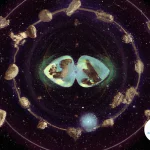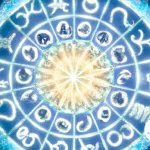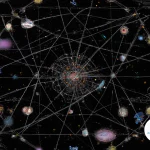Unlock the Mysteries and Insights of Astrological Aspects
Astrology has long captivated the human imagination, offering a profound lens through which we can understand ourselves and the world around us. One key aspect of astrology lies in the study of astrological aspects, which holds the key to unlocking hidden potential, identifying challenges, and understanding the dynamics between celestial bodies. In this comprehensive guide, we dive deep into the meaning and significance of astrological aspects, exploring the different types, how they influence personality, and practical examples of their impact. Whether you are a seasoned astrologer or new to the cosmic realms, this article will equip you with the knowledge to navigate and interpret these celestial connections. So, grab your astrological chart, prepare for an enlightening journey, and let’s uncover the secrets of astrological aspects together.
What are Astrological Aspects?

Astrological aspects are the relationships formed between celestial bodies in an astrological chart. They represent the angles or distances between planets, the Sun, the Moon, and other significant points in the chart. These aspects shape the energy and influence of each celestial body, creating a complex web of connections that offer valuable insights into an individual’s personality, strengths, challenges, and potential life experiences. Understanding these aspects is crucial for in-depth astrology analysis, as they provide the framework for interpreting the cosmic energies at play in a person’s life. Whether two planets are harmoniously aligned or in tense opposition, these aspects offer a language through which astrologers can communicate the intricate dance of the celestial bodies. By exploring the significance of each aspect, astrologers can uncover a wealth of information about a person’s character, relationships, and life experiences. So, join us on this celestial journey as we unravel the intricate tapestry of astrological aspects and unlock the secrets of the cosmos.
The Different Types of Astrological Aspects
There are several different types of astrological aspects, each with its own unique energy and influence on an individual’s chart. These aspects provide valuable information about the relationship between celestial bodies and offer deeper insights into a person’s personality and life experiences. The most common types of astrological aspects include:
- Conjunction: This aspect occurs when two planets are in close proximity, merging their energies to create a potent force of expression. It can signify intense focus and power in specific areas of life.
- Opposition: An opposition occurs when two planets are directly across from each other, creating a dynamic tension between their energies. It represents the need to balance opposing forces and find harmony through integration.
- Trine: The trine aspect forms when two planets are approximately 120 degrees apart, creating a harmonious and flowing connection. It signifies natural talents, ease, and opportunities in specific areas of life.
- Square: A square aspect occurs when two planets are approximately 90 degrees apart, creating a sense of tension and challenge. It represents areas of friction, conflict, and the need for growth and change.
- Sextile: The sextile aspect forms when two planets are approximately 60 degrees apart, creating opportunities for growth, creativity, and positive connections. It signifies areas of talent and the potential for harmonious cooperation.
Understanding the various types of astrological aspects provides astrologers and enthusiasts with a powerful tool for interpreting and understanding the complexities of an individual’s birth chart. Each aspect brings a unique energy and influence, shaping one’s personality traits, life events, and opportunities for growth. By delving deeper into these aspects, we can unlock a deeper understanding of our true selves and the cosmic forces at play in our lives.
1. Conjunction
A conjunction occurs when two celestial bodies align in close proximity, usually within the same zodiac sign. This aspect represents a merging and blending of energies, creating a powerful influence that can greatly impact an individual’s personality and life experiences. When planets are in conjunction, their energies combine, amplifying each other’s effects. This can manifest in various ways, depending on the planets involved. For example, a conjunction between the Sun and Mercury can enhance communication skills and intellectual capabilities, making the individual articulate and mentally sharp. On the other hand, a conjunction between Mars and Pluto can intensify ambition, drive, and even assertiveness to the point of obsession or power struggles. It’s important to note that not all conjunctions are inherently positive or negative. The overall impact depends on the specific planets involved and their individual characteristics. It is also important to consider the sign and house placement of the conjunction within the natal chart, as this provides additional context and nuance to its interpretation. To explore your own conjunctions and their meanings, check your natal chart or consult with a professional astrologer who can provide personalized insights.
2. Opposition
The aspect known as opposition occurs when two celestial bodies are approximately 180 degrees apart in the astrological chart, creating a sense of tension and polarity. It represents a dynamic relationship between two forces that seem to pull in opposite directions, often resulting in a state of conflict or contrast in the individual’s life. When planets are in opposition, their energies are in direct opposition to each other, highlighting opposing qualities or needs within the person’s psyche. This aspect symbolizes the need for balance and integration of these conflicting energies. While the opposition can bring challenges, it also offers an opportunity for growth and self-awareness. It invites individuals to recognize and reconcile the opposing forces within themselves and find a harmonious middle ground. For example, if the Moon is in opposition to Saturn in a birth chart, there may be a conflict between emotional needs and a sense of responsibility or restriction. This aspect suggests the need to find a balance between nurturing oneself and fulfilling obligations. By understanding and working with the energy of opposition, individuals can navigate these inner tensions and find a path towards greater harmony and personal growth. To further explore the significance of opposition and its impact on relationships, you can check out our article on Sagittarius love compatibility.
3. Trine
A trine is one of the most harmonious and positive astrological aspects. It occurs when two celestial bodies are approximately 120 degrees apart, forming a triangle-like pattern in the astrological chart. This aspect signifies a flowing and supportive energy between the planets involved, creating a sense of ease and cooperation.
When two planets are in trine, they work together effortlessly, amplifying each other’s positive qualities and offering opportunities for growth and abundance. The trine aspect encourages the free flow of energy and communication between these planets, allowing them to work in harmony towards common goals.
In astrology, trines are often associated with natural talents, creativity, and good fortune. They can indicate areas of life where individuals have innate abilities and are likely to experience success with relative ease. The energy of the trine allows for smooth integration of the qualities represented by the planets involved, fostering a sense of harmony and balance.
For example, a trine between the Sun and Jupiter suggests a person who possesses a natural sense of optimism, confidence, and expansive vision. This aspect often brings opportunities for personal growth and abundance, as well as a strong belief in oneself and the ability to attract positive outcomes.
While trines are generally positive, it’s important to note that they can sometimes create a sense of complacency or lack of motivation. Due to the ease and flow of energy associated with trines, individuals may rely too heavily on their natural talents and not push themselves to strive for further development or growth.
To make the most of a trine aspect, it is essential to harness the positive energy it provides while also maintaining a proactive approach. By actively engaging with the gifts and opportunities presented by the trine, individuals can unlock their full potential and achieve even greater success.
Trines are astrological aspects that symbolize harmony, cooperation, and effortless flow between planets. They indicate areas of life where individuals possess natural talents and are likely to experience positive outcomes. While trines offer gifts and opportunities, it’s important to stay motivated and continue to work towards personal and spiritual growth. So, embrace the blessings of trine aspects and embark on a journey of self-discovery and fulfillment.
For more insights into the zodiac and astrology, check out our guide to discovering your true zodiac sign. Additionally, if you want to unlock the potential of your Sun sign, be sure to read our tips on unleashing your Sun sign’s potential.
4. Square
The square aspect is one of the most dynamic and challenging astrological aspects. When two planets form a square in an astrological chart, they are approximately 90 degrees apart. This aspect creates tension, friction, and conflict between the energies represented by the planets involved. It symbolizes internal struggles and a need to find balance between conflicting desires or goals. People with a strong square aspect in their chart often face obstacles and difficulties in the areas of life represented by the planets involved.
For example, a square between Mars and Saturn may indicate a constant battle between assertiveness and discipline. These individuals may experience frustration and a sense of limitation in expressing their personal drive and ambitions. However, with awareness and conscious effort, the square aspect can be a catalyst for growth and transformation. It presents an opportunity to develop resilience, persistence, and the ability to overcome challenges.
In interpreting a square aspect, it is essential to consider the signs and houses the planets are in, as well as any other aspects they form. The signs can provide insight into the specific qualities of the tension, while the houses indicate the life areas where the struggle is likely to manifest. By understanding the nature of the square aspect and working with its energy consciously, individuals can harness its transformative potential and navigate the complexities of life with greater wisdom and resilience.
5. Sextile
The sextile is an astrological aspect that occurs when two celestial bodies are approximately 60 degrees apart. It is considered a favorable aspect, bringing opportunities and harmonious energy between the planets involved. The sextile encourages cooperation, creativity, and positive interactions. This aspect allows the energies of the planets to blend seamlessly, facilitating smooth communication and effortless collaboration. It promotes compatibility, making it easier for individuals to work together towards shared goals. The sextile fosters a sense of ease and flow, allowing individuals to tap into their potential and express themselves freely. It is a gentle nudge towards personal growth and development. For example, a sextile between the Sun and Mercury can enhance communication skills, supporting the expression of ideas and fostering effective self-expression. Similarly, a sextile between Venus and Mars can bring harmony and balance to romantic relationships, promoting an exciting and harmonious connection between desire and action. The sextile offers a range of possibilities for growth and positive outcomes, allowing individuals to embrace their unique talents and navigate life’s challenges with grace and ease. So, when you encounter a sextile in your astrological chart, embrace the opportunities it presents and harness its favorable energy to enhance various aspects of your life.
Interpreting Astrological Aspects
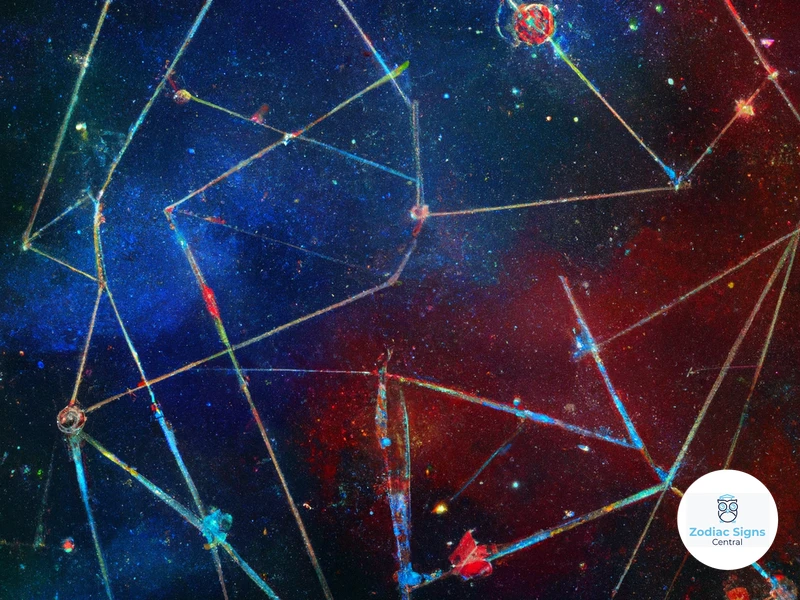
Interpreting astrological aspects requires a deep understanding of the unique dynamics and energies that each aspect represents. Here is a breakdown of some common astrological aspects and their interpretations:
Conjunction: Occurs when two planets are within a close proximity of each other, intensifying their combined energies. Conjunctions often signify a merging of energies, resulting in a heightened focus and concentration in the area of life represented by the planets involved. For example, a conjunction between Venus and Mars may indicate passion and intense desire in relationships.
Opposition: Reflects a tension or conflict between two planets, as they are directly opposite each other in the chart. Oppositions often represent a need for balance and integration of the energies represented by the planets. For instance, an opposition between the Sun and Moon may indicate a struggle between one’s conscious and emotional selves, requiring reconciliation and harmony.
Trine: Formed when two planets are approximately 120 degrees apart, creating a harmonious and flowing connection. Trines signify ease and natural talents in the areas of life represented by the planets involved. For instance, a trine between Mercury and Jupiter may indicate a strong ability to communicate and think expansively.
Square: Occurs when two planets are approximately 90 degrees apart, creating a challenging and dynamic energy. Squares represent tension, obstacles, and growth opportunities. They often indicate areas of friction and conflict that need to be addressed for personal growth and development. For example, a square between Saturn and Uranus may indicate a tension between tradition and change, requiring the individual to find a balance between the two.
Sextile: Formed when two planets are approximately 60 degrees apart, creating a supportive and harmonious connection. Sextiles represent opportunities for growth, productivity, and cooperation. They indicate areas where positive energy and opportunities may flow easily. For instance, a sextile between Venus and Jupiter may indicate luck and abundance in relationships and finances.
By studying and analyzing these various astrological aspects, an astrologer is able to gain valuable insights into a person’s character, potentials, and challenges. The specific aspects in a person’s birth chart provide a roadmap for understanding how different energies and influences interact and shape their life experiences. The interpretation of these aspects is key to unlocking the deeper meaning and significance behind the celestial patterns in an astrological chart.
How Astrological Aspects Influence Personality
Astrological aspects hold immense power in shaping an individual’s personality. Each aspect brings a unique energy and dynamic to the overall astrological makeup. Here are some key ways in which astrological aspects influence personality:
1. Conjunction: A conjunction occurs when two or more celestial bodies align closely. This aspect intensifies the energies involved, amplifying their impact on the individual’s personality traits. It can create a strong focus and concentration in the areas influenced by these planets.
2. Opposition: An opposition represents a direct 180-degree angle between two celestial bodies. This aspect often brings internal conflict and tension as the energies of the planets involved pull in opposing directions. It can lead to a constant need for balance and integration between the two spheres of life represented by these planets.
3. Trine: A trine forms when two celestial bodies are approximately 120 degrees apart. This aspect indicates ease and harmony between the planets, creating a flow of beneficial energy. It can enhance natural talents, creativity, and opportunities in the areas influenced by these planets.
4. Square: A square occurs when celestial bodies are approximately 90 degrees apart. This aspect often brings challenges and obstacles as the energies of the planets clash. It can create tension and the need for growth, pushing individuals to overcome limitations and find innovative solutions.
5. Sextile: A sextile represents an angle of approximately 60 degrees between two celestial bodies. This aspect brings opportunities and positive energy, facilitating communication and cooperation between the planets involved. It can enhance productivity, learning, and harmonious relationships.
These aspects, along with other lesser-known ones, interact and combine to form a unique astrological profile for each individual. The specific placements and configurations of these aspects within a birth chart can shed light on the different facets of a person’s personality, strengths, challenges, and potential life experiences. Understanding the influence of these aspects is an essential tool for astrologers to gain deeper insights into an individual’s character and life journey.
Examples of Astrological Aspects in Action
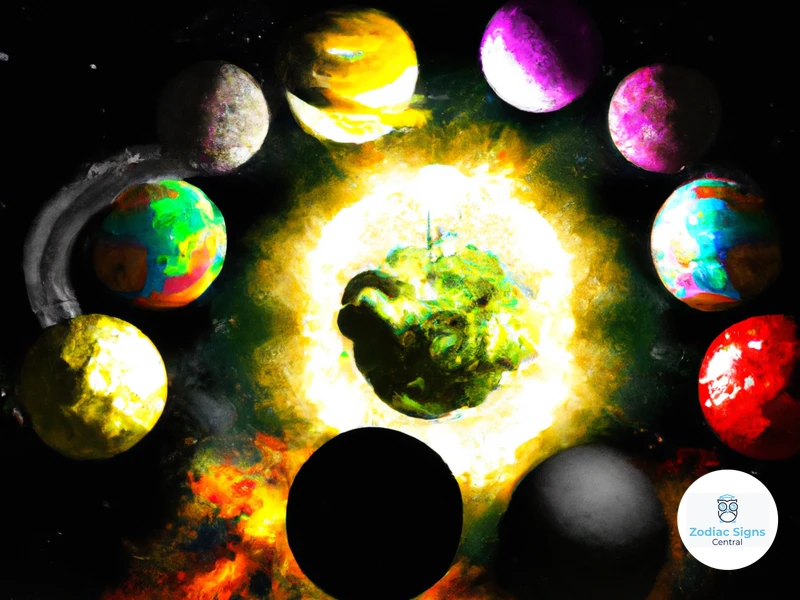
Astrological aspects come to life through real-life examples that showcase their impact and significance. One powerful example is the Sun Conjunct Moon aspect, where the Sun and Moon are in close proximity in the same zodiac sign. This aspect symbolizes a harmonious integration of the conscious (Sun) and unconscious (Moon) aspects of the self, resulting in a strong sense of self-awareness and emotional intelligence. Another example is the Mars Square Venus aspect, which signifies tension and conflict between the assertive and passionate energy of Mars and the harmonizing and loving energy of Venus. This aspect often reflects challenges and struggles in relationships, requiring individuals to find compromise and balance between their desires and the needs of their partners. Additionally, the Jupiter Trine Saturn aspect represents a harmonious balance between expansion (Jupiter) and discipline (Saturn), offering individuals the opportunity for growth and success through hard work and perseverance. Through these examples, we can see how astrological aspects play a crucial role in shaping our personalities, relationships, and life experiences.
1. Sun Conjunct Moon
1. Sun Conjunct Moon: In astrology, the aspect of Sun conjunct Moon occurs when the Sun and the Moon are in the same zodiac sign and are closely aligned in the birth chart. This aspect is considered highly significant and powerful, as it combines the core essence of the individual’s identity (represented by the Sun) with their emotions and instinctual nature (represented by the Moon). People with this aspect possess a strong sense of self-awareness and a deep connection between their conscious and unconscious selves. They tend to have a clear understanding of their emotional needs and can harmonize their inner desires with their outward actions. Sun conjunct Moon individuals are often highly intuitive, empathetic, and expressive in their emotions. They have a natural ability to empathize with others and connect on a deep emotional level, making them compassionate and understanding companions. This aspect also signifies a sense of unity between one’s inner masculine and feminine energies, allowing for a balanced and integrated expression of both. Sun conjunct Moon is a powerful aspect that brings together the essential elements of an individual’s being, fostering a strong sense of self-awareness, emotional depth, and an ability to connect with others on a profound level.
2. Mars Square Venus
2. Mars Square Venus:
One of the most potent and dynamic aspects in astrology is the Mars square Venus aspect. When Mars, the planet associated with passion, action, and assertiveness, forms a square aspect with Venus, the planet of love, beauty, and relationships, it creates a tension and conflict between these two energies. This aspect often indicates intense emotional and sexual desires, which can lead to power struggles and conflicts in relationships. Individuals with this aspect may have a difficult time finding a balance between their assertiveness and their desire for harmonious connections. They may have a tendency to be impulsive or argumentative, which can create challenges in their love life. However, the Mars square Venus aspect also holds the potential for intense passion and magnetic attraction. Despite the conflicts it brings, it can ignite a spark that fuels creativity and transformation in relationships. It’s important for individuals with this aspect to develop self-awareness and learn how to channel their assertiveness in a productive and compassionate way. By understanding and balancing these opposing forces, individuals can navigate the challenges and harness the transformative power of the Mars square Venus aspect in their lives.
3. Jupiter Trine Saturn
3. Jupiter Trine Saturn: The Harmonious Dance of Expansion and Structure
The Jupiter trine Saturn aspect is an astrological configuration that brings together the energies of these two powerful planets, creating a harmonious and supportive connection. Jupiter represents expansion, growth, opportunities, and luck, while Saturn symbolizes structure, discipline, responsibility, and practicality. When these two planets form a trine aspect, they work together in a cooperative and balanced manner, allowing individuals to combine their aspirations for growth with the necessary discipline and focus to achieve their goals. This aspect encourages a harmonious blend of optimism and realism, providing a solid foundation for long-term success. People with this aspect in their natal charts are often able to manifest their dreams and ambitions through hard work and strategic planning. They possess the ability to set realistic goals, stay disciplined, and persevere through challenges. Jupiter trine Saturn fosters a sense of responsibility and a strong work ethic, making these individuals reliable, organized, and dependable. This aspect also promotes a balanced approach to life, encouraging individuals to seek both personal fulfillment and worldly success. It supports individuals in finding a harmonious balance between expansion and stability, ensuring that their growth is grounded and sustainable. In relationships, this aspect can indicate a stable and enduring partnership, built on strong foundations of trust, shared values, and mutual support. Ultimately, the Jupiter trine Saturn aspect brings together the best of both worlds, blending idealism with practicality and offering individuals the opportunity to achieve their goals with integrity and long-lasting success.
Working with Astrological Aspects
To work effectively with astrological aspects, it is important to understand a few key concepts. One of these concepts is aspect orbs, which determine the allowable range of degrees in which an aspect is considered active. Astrologers use different orb sizes, depending on the planetary pairings and the individual’s preference. It is also crucial to avoid an overemphasis on negative aspects. While challenging aspects can present obstacles and difficulties, they also offer opportunities for growth and transformation. Rather than dwelling solely on the negative aspects, it is essential to harness the power of positive aspects. These harmonious connections can amplify strengths, enhance opportunities, and bring about favorable outcomes. By focusing on the positive aspects, individuals can maximize their potential and navigate life’s challenges with greater ease. So remember, when working with astrological aspects, understanding aspect orbs, avoiding overemphasis on negative aspects, and harnessing the power of positive aspects are all key factors in unlocking the transformative power of astrology.
1. Understanding Aspect Orbs
Aspect orbs are a crucial concept in astrology that determine the allowable range of difference between celestial bodies to form an astrological aspect. They represent the degree of variation that astrologers consider when analyzing aspects in a birth chart or during transit readings. Aspect orbs vary based on the type of aspect being analyzed and personal astrological interpretation.
For example, when examining a conjunction aspect, which occurs when two celestial bodies are in the same degree or very close, a common orb range might be around 8 degrees. This means that if two planets are within approximately 8 degrees of each other, they would still be considered as forming a conjunction aspect.
On the other hand, when considering a more precise aspect like the trine, which represents 120 degrees between celestial bodies, the orb range might be much narrower, such as 3-4 degrees.
Understanding aspect orbs is essential for accurate astrological analysis as it allows astrologers to consider a wider or narrower range of aspect influence when interpreting a birth chart or predicting future events. Different astrologers may use slightly different orb ranges based on their experience and personal preferences, so it’s important to keep this in mind when seeking astrological advice or interpreting your own chart. By delving into the intricacies of aspect orbs, astrologers can paint a more nuanced and accurate picture of the celestial alignments influencing an individual’s life.
2. Avoiding Overemphasis on Negative Aspects
When interpreting astrological aspects, it is important to avoid overemphasis on negative aspects. While challenging aspects such as squares and oppositions can indicate areas of tension or difficulty, they should not be viewed in isolation. The overall birth chart and the presence of positive aspects can provide balance and opportunities for growth. Here are some key points to consider:
- Context is crucial. Rather than fixating solely on negative aspects, look at the entire chart and consider the overall themes and patterns. Negative aspects may be balanced by positive aspects or other mitigating factors.
- Focus on growth and transformation. Rather than seeing negative aspects as obstacles, view them as opportunities for personal development. They can serve as catalysts for change and provide valuable lessons.
- Remember the power of free will. While astrological aspects can indicate potential challenges, it is ultimately up to the individual how they respond to these influences. By cultivating self-awareness and making conscious choices, it is possible to navigate difficulties with resilience and strength.
- Seek guidance when needed. If you find yourself getting overwhelmed or overly focused on negative aspects, consider consulting with an experienced astrologer who can provide a fresh perspective and help you see the bigger picture.
It is important to approach astrological aspects with an open mind and remember that they are just one part of a larger cosmic picture. By keeping a balanced perspective and focusing on personal growth, we can harness the potential of both positive and challenging aspects to lead fulfilling and empowered lives.
3. Harnessing the Power of Positive Aspects
Harnessing the power of positive aspects in astrology can bring about tremendous growth and fulfillment in various areas of life. Positive aspects, such as trines and sextiles, signify harmonious connections between celestial bodies, creating an easy flow of energy and favorable circumstances. To make the most of these aspects, it is essential to understand their potential and leverage them effectively. Here are some strategies for harnessing the power of positive aspects:
- Recognize the Opportunities: Positive aspects offer opportunities for growth, abundance, and success. When you identify these aspects in your birth chart or during transits, pay attention to the areas of life they influence. Whether it’s career, relationships, or personal development, be aware of the potential blessings that lie ahead.
- Cultivate Self-Awareness: Understand how these aspects manifest within you. For example, if you have a trine between your Sun and Mars, it signifies inner harmony and synergy between your willpower and self-expression. By recognizing these qualities, you can consciously channel them into productive outlets, such as pursuing creative endeavors or taking on leadership roles.
- Take Action: Positive aspects provide favorable circumstances, but they still require action and effort on your part. Embrace the opportunities that come your way and take steps towards your goals. If you have a sextile between Mercury and Venus, it may enhance your communication and social skills. Use this aspect to strengthen relationships, network, and express yourself effectively.
- Embrace Collaboration: Positive aspects often indicate good compatibility and synergistic energy between people. If you notice positive aspects in your synastry chart or compatibility analysis, consider working together, collaborating on projects, or cultivating meaningful connections. These aspects can bring about fruitful partnerships and enhance teamwork.
- Gratitude and Positivity: Embracing a positive mindset and expressing gratitude for the blessings in your life can amplify the effects of positive aspects. Practice affirmations, visualization, and gratitude rituals to align yourself with the positive energies around you. This can enhance your overall well-being and attract more favorable experiences.
Remember, harnessing the power of positive aspects requires self-awareness, intention, and proactive steps towards personal growth. By embracing these aspects and working with their energies, you can unlock your full potential and create a life filled with abundance and fulfillment.
Synastry: Astrological Aspects in Relationships

When it comes to relationships, astrology offers a powerful tool called synastry, which examines the compatibility and dynamics between two individuals by analyzing their astrological aspects. In synastry, the aspects formed between the planets and points in each person’s chart reveal the strengths, challenges, and overall compatibility between them. These aspects provide valuable insights into the dynamics and potential areas of synergy or conflict in a relationship. For example, a harmonious aspect like a /trine or a /sextile can indicate a natural flow of energy and a strong connection between partners. On the other hand, challenging aspects such as a /square or an /opposition may signify areas of tension or conflict that need to be understood and addressed for the relationship to thrive. By examining the synastry aspects, astrologers can provide guidance and understanding to individuals looking to navigate and enhance their relationships. Whether you’re exploring a new partnership or seeking to deepen the bond in an existing one, synastry can provide invaluable insights into the dynamics of your connection.
Transits: Astrological Aspects in Action
Transits are a powerful tool in the world of astrology, allowing us to understand the dynamic energies at play in our lives on a daily and long-term basis. These astrological aspects occur when a planet’s current position interacts with the planets and points in our birth chart. As these transiting planets move and make specific connections with our natal planets, they stimulate different energies and influences, shaping our experiences and triggering significant events. Major transits correlate with life-changing events, such as career advancements, relationships, or personal transformations. Daily transits, on the other hand, influence our emotional states and daily energies. By understanding these transits and the aspects they form, individuals gain valuable insight into the cosmic forces shaping their journey. So, whether it’s a major life event or a small emotional shift, transits offer a profound understanding of the astrological energies in action, enabling us to navigate and embrace our destinies with awareness and empowerment.
1. Major Transits and Life Events
Major transits in astrology refer to the movements of the planets as they make significant aspects to the natal chart. These transits often coincide with important life events and can have a profound impact on an individual’s journey. When a major transit occurs, it signifies a period of change, growth, or challenge that has the potential to shape one’s life path.
One example of a major transit is when the transiting Saturn makes a conjunction aspect to a natal planet. This transit is often associated with a period of increased responsibility, discipline, and hard work. It may bring about a time of maturity, where one is called to face the realities of life and make necessary adjustments.
Another major transit to consider is the Pluto square, which occurs when transiting Pluto forms a square aspect to a natal planet. This transit has a transformative energy and can bring about deep internal changes and powerful external events. It can signal a time of intense personal growth, letting go of old patterns, and embracing personal empowerment.
Additionally, the Jupiter opposition is a major transit that occurs when transiting Jupiter opposes a natal planet. This transit often brings opportunities for expansion, growth, and abundance. It can signify a period of increased optimism, exploration, and new possibilities.
It’s important to note that the specific outcomes of major transits will vary depending on the natal chart and the planets involved. The house placement, sign, and aspects of the natal planet being transited will also influence the manifestation of these transits.
During major transits, it is common for individuals to experience significant life events such as career changes, relationship shifts, personal breakthroughs, or even major milestones. These transits often act as catalysts for personal evolution and can bring about meaningful shifts in various areas of life.
To fully understand the impact and potential of major transits, it is recommended to consult with an experienced astrologer who can analyze the specific details of your birth chart and provide insights into the significance of these transits in your life. Stay attuned to the energies at play during major transits and embrace the opportunities they present for growth and transformation.
2. Daily Transits and Emotional Energies
Daily transits are the ever-shifting positions of the planets in relation to an individual’s natal chart. These transits exert a significant influence on our daily lives, impacting our emotions, energy levels, and overall experiences. Each day brings a different combination of planetary movements, creating a unique cosmic tapestry that colors our emotional landscape.
When examining daily transits, astrologers pay particular attention to the aspects formed between the transiting planets and the natal planets. These aspects can create a range of emotional energies that can be felt on a daily basis. For example, a harmonious aspect such as a trine or sextile can bring feelings of ease, flow, and positive energy. This may manifest as a sense of emotional well-being, heightened creativity, and smooth interactions with others.
On the other hand, challenging aspects like squares or oppositions can stir up tension, conflicts, and emotional turmoil. These transits may bring about challenges and tests that require emotional resilience and adaptability. It’s important to note that the intensity and duration of these emotional energies vary depending on the specific planetary combinations and individual charts.
To navigate daily transits, it’s helpful to stay attuned to your emotions and observe any shifts or patterns that arise. You can keep a journal to track how different transits affect your mood, energy levels, and overall well-being. Recognizing the influence of daily transits can provide valuable insights into understanding your emotional responses and help you make conscious choices to navigate challenges or embrace opportunities.
Daily transits offer a dynamic landscape of emotional energies that ebb and flow from day to day. By embracing the knowledge of astrology and being mindful of the daily transits, you can cultivate a deeper sense of self-awareness and harness the cosmic energies to support your emotional well-being and personal growth.
Conclusion

In conclusion, astrological aspects are a vital component of astrology that allow us to delve deeper into the intricacies of our lives and personalities. They provide us with valuable insights into the relationships and interactions between celestial bodies, shaping the energies that influence our behavior, emotions, and life experiences. By understanding and interpreting these aspects, we can gain a deeper understanding of ourselves, our potential challenges, and our unique strengths. Astrological aspects not only provide us with guidance for personal growth but also offer a framework for understanding the dynamics of relationships and the impact of cosmic energies on our daily lives. As we explore the depths of astrological aspects, we uncover a rich tapestry of interconnectedness and hidden patterns that bring meaning and purpose to our existence. So, embrace the power of astrological aspects and let the wisdom of the cosmos guide you on your journey of self-discovery and enlightenment.
Frequently Asked Questions
1. What is the significance of astrological aspects in an astrological chart?
Astrological aspects in a chart represent the relationships and angles between celestial bodies, offering insights into a person’s personality traits, strengths, and challenges. They provide the framework for interpreting the energies at play in an individual’s life.
2. How many types of astrological aspects are there?
There are several types of astrological aspects, including conjunctions, oppositions, trines, squares, and sextiles. Each aspect has a unique influence on the energy between celestial bodies.
3. What does a conjunction aspect indicate?
A conjunction aspect occurs when two planets are closely aligned in the same zodiac sign. It signifies a powerful blending of energies, amplifying the traits associated with those planets and the qualities of the zodiac sign.
4. How does an opposition aspect manifest?
An opposition aspect occurs when two planets are across from each other in the zodiac. It represents a dynamic tension and the need to find balance between the energies of the planets involved.
5. What is the influence of a trine aspect?
A trine aspect occurs when two planets are approximately 120 degrees apart. It signifies harmony, ease, and natural flow between the energies of the planets involved, allowing their qualities to support and enhance each other.
6. What does a square aspect represent?
A square aspect occurs when two planets are approximately 90 degrees apart. It creates tension and challenges, pushing individuals to face and overcome obstacles in order to grow and evolve.
7. How does a sextile aspect influence the energies between planets?
A sextile aspect occurs when two planets are approximately 60 degrees apart. It offers opportunities, facilitating positive and harmonious interactions between the energies of the planets involved.
8. How do astrological aspects influence personality?
Astrological aspects can reveal patterns and dynamics in a person’s character. They can shed light on strengths, challenges, and potential life experiences, providing valuable insights into an individual’s personality and behaviors.
9. What are aspect orbs?
Aspect orbs refer to the permissible degree of difference allowed when measuring the exactness of an aspect. They determine the strength and influence of an aspect, with tighter orbs indicating a stronger connection.
10. How do astrological aspects impact relationships?
Astrological aspects can greatly impact relationships by influencing the compatibility and dynamics between individuals. Harmonious aspects can enhance connection and understanding, while challenging aspects may create tension and the need for growth and compromise.
References
- The Complete Guide to Astrological Aspects
- Astrological aspect
- How to Find and Interpret Aspects in Astrology
Frequently Asked Questions
1. What role do astrological aspects play in a birth chart?
Astrological aspects in a birth chart indicate the relationship between celestial bodies and how they influence your personality traits and life events.
2. Can astrological aspects change over time?
Astrological aspects are based on the positions of celestial bodies at the time of your birth and remain constant throughout your life. However, the influence of aspects can shift as planets continue to move in the sky.
3. How do conjunctions differ from other astrological aspects?
Conjunctions occur when two celestial bodies are in close proximity in the same zodiac sign, merging their energies. They tend to intensify the traits associated with those planets.
4. What does an opposition aspect represent?
An opposition aspect occurs when two celestial bodies are directly opposite each other in the zodiac. It often signifies a tension or conflict between the energies of these planets.
5. How can trine aspects be beneficial?
Trine aspects indicate harmonious energy flow between two celestial bodies, bringing ease and natural talents in the areas represented by those planets.
6. What challenges can arise from square aspects?
Square aspects create tension and conflict between two planets, often resulting in challenges, obstacles, and the need for growth and transformation in the areas represented by those planets.
7. What does a sextile aspect indicate?
Sextile aspects represent opportunities for growth, collaboration, and creative expression. They enable the blending and integration of energies between two planets.
8. How do astrological aspects influence personality?
Astrological aspects shape personality by indicating how celestial bodies interact, influencing traits and tendencies, strengths and weaknesses, and the overall energy dynamics within an individual’s birth chart.
9. Can you give an example of a positive astrological aspect in action?
An example of a positive astrological aspect is the trine between Jupiter and Venus, which can bring luck, abundance, and harmonious relationships.
10. How do astrological aspects affect relationships?
Astrological aspects play a key role in relationships as they indicate compatibility, communication styles, and potential challenges between individuals based on the interaction of their birth charts.
References
- Everything You Need To Know About Aspects In Astrology
- The Meaning of the Aspects in Astrology
- The Aspects




